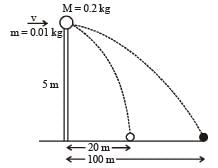Test: MCQs (One or More Correct Option): Momentum and Impulse | JEE Advanced - JEE MCQ
10 Questions MCQ Test 35 Years Chapter wise Previous Year Solved Papers for JEE - Test: MCQs (One or More Correct Option): Momentum and Impulse | JEE Advanced
Two particles of masses m1 and m2 in projectile motion have velocities  respectively at time t = 0. They collide at time to. Their velocities become
respectively at time t = 0. They collide at time to. Their velocities become  at time 2to while still moving in air. The value of
at time 2to while still moving in air. The value of 
 respectively at time t = 0. They collide at time to. Their velocities become
respectively at time t = 0. They collide at time to. Their velocities become  at time 2to while still moving in air. The value of
at time 2to while still moving in air. The value of 
Two blocks of masses 10 kg and 4 kg are connected by a spring of negligible mass and placed on a frictionless horizontal surface. An impulse gives a velocity of 14 m/s to the heavier block in the direction of the lighter block. The velocity of the centre of mass is
| 1 Crore+ students have signed up on EduRev. Have you? Download the App |
A ball of mass 0.2 kg rests on a vertical post of height 5 m. A bullet of mass 0.01 kg, traveling with a velocity V m/s in a horizontal direction, hits the centre of the ball. After the collision, the ball and bullet travel independently. The ball hits the ground at a distance of 20 m and the bullet at a distance of 100 m from the foot of the post. The velocity V of the bullet is


A particle of mass m is projected from the ground with an initial speed u0 at an angle α with the horizontal. At the highest point of its trajectory, it makes a completely inelastic collision with another identical particle, which was thrown vertically upward from the ground with the same initial speed u0. The angle that the composite system makes with the horizontal immediately after the collision is
A ball hits the floor and rebounds after an inelastic collision. In this case
A shell is fired from a cannon with a velocity v (m/sec.) at an angle θ with the horizontal direction. At the highest point in its path it explodes into two pieces of equal mass. One of the pieces retraces its path to the cannon and the speed (in m/sec.) of the other piece immediately after the explosion is
Two blocks A and B, each of mass m, are connected by a massless spring of natural length L and spring constant K.
The blocks are initially resting on a smooth horizontal floor with the spring at its natural length, as shown in fig.. A third identical block C, also of mass m, moves on the floor with a speed v along the line joining A and B, and collides elastically with A. Then

The balls, having linear momenta  undergo a collision in free space. There is no external force acting on the balls. Let
undergo a collision in free space. There is no external force acting on the balls. Let  be their final momenta. The following option (s) is (are) NOT ALLOWED for any non-zero value of p, a1, a2, b1, b2, c1 and c2.
be their final momenta. The following option (s) is (are) NOT ALLOWED for any non-zero value of p, a1, a2, b1, b2, c1 and c2.
A point mass of 1 kg collides elastically with a stationary point mass of 5 kg. After their collision, the 1 kg mass reverses its direction and moves with a speed of 2 ms–1. Which of the following statement(s) is (are) correct for the system of these two masses?
A particle of mass m is attached to one end of a mass-less spring of force constant k, lying on a frictionless horizontal plane. The other end of the spring is fixed. The particle starts moving horizontally from its equilibrium position at time t = 0 with an initial velocity u0. When the speed of the particle is 0.5 u0, it collides elastically with a rigid wall. After this collision
|
347 docs|185 tests
|
|
347 docs|185 tests
|




















 Therefore the final linear momentum should also be zero.
Therefore the final linear momentum should also be zero. Final momentum.
Final momentum. components become zero. But the third term having
components become zero. But the third term having  component is non-zero. This gives a definite final momentum to the system which violates conservation of linear momentum, so this is an incorrect option.
component is non-zero. This gives a definite final momentum to the system which violates conservation of linear momentum, so this is an incorrect option. because b1 ≠ 0
because b1 ≠ 0




 Therefore option (b) is incorrect
Therefore option (b) is incorrect
 Therefore option c is incorrect.
Therefore option c is incorrect.















